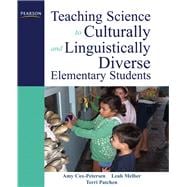
Note: Supplemental materials are not guaranteed with Rental or Used book purchases.
Purchase Benefits
What is included with this book?
Amy Cox-Petersen, Ph.D. has over 25 years of experience within multiple educational settings. She holds a BS in Early Childhood Education and a MA in Elementary Education from East Carolina University and a Ph.D. in Curriculum and Instruction with a Science Education Specialization from the University of Southern California. She has presented internationally and nationally on topics related to science teacher education and learning science outside the formal classroom. Her research focuses on culturally relevant science teaching and learning in classrooms, field sites, museums, and service-learning settings. She is the author of “Educational Partnerships: Connecting Schools, Families, and the Community” (Sage, 2010). She taught in urban, suburban, and rural schools as an elementary and middle school teacher. She joined the faculty at California State University, Fullerton in 1998 and is currently a professor in the Department of Elementary and Bilingual Education.
Leah M. Melber, Ph.D. has 20 years experience within informal and formal science education. She holds a BA in Zoology, an MA in education together with a multiple subject teaching credential for the state of California, and a Ph.D. in educational psychology from the University of Southern California. She has presented internationally on inquiry-based instruction and effective methods of connecting with cultural institutions such as museums. In addition to numerous journal articles she has written on this topic, she recently authored the book “Informal Learning and Field Trips”. She was awarded the 2001 Informal Educator Award through the California Science Teachers Association and the 2010 Promising Leadership Award from the Association of Midwest Museums. She was recently accepted as a candidate on the Fulbright Specialist Roster in the focus area of education. She is a former third grade teacher and university professor in science education. She also served as the Science Education Specialist at the Natural History Museum of Los Angeles County in addition to serving as a consultant in the area of informal education for museums around the nation. She joined the staff of Lincoln Park Zoo in December of 2008 where she is currently the Director of Student and Teacher Programs.
Terri Patchen, Ph.D. is an Associate Professor in the Department of Elementary and Bilingual Education at California State University, Fullerton. A credentialed bilingual teacher, she taught kindergarten in a lower-income, Spanish speaking classroom for close to ten years before getting graduate degrees in Urban Planning and Latin American Studies, and a Ph.D. in Education from the University of California, Los Angeles. She has published in journals as diverse as Multicultural Education and Science Education and regularly presents at education conferences. She is a lifelong advocate for the benefits of working with English learners.
Teaching Science with Access for all Students
Eight Explicit Strategies to Encourage Cultural Relevant Science Instruction
Challenges for Students from Non-English Language Backgrounds
Case Study 1.1: Snapshot of Ahna’s Culturally Relevant Classroom
Chapter 2: Culturally Relevant Inquiry and Action
Scientific Methods and Processes
Inquiry Process Skills
Teacher as Facilitator
Effective Use of Questioning
Allowing Students to be Experts
Integrating Inquiry across the Curriculum
Extending the Walls of the Classroom
Building Fluency outside the Classroom
Case Study 2.1: Expect the Unexpected
Chapter 3: Literacy Development through Science
Importance of Authentic Connections
Language Arts and the Work of Scientists
Reviewing Information Sources
Sharing Discoveries
Extending the Experience
Case Study 3.1: Sixth Grade Service Learning Project
Chapter 4: Teaching Strategies that Promote Science Access for All Students
Learner Differences
Integrating Cognitive Views of Learning
Inquiry Models
Making Models of Teaching more Culturally Relevant
Case Study 4.1: Teachers and Students participating in a Group Investigation science activity
Chapter 5: Assessment, Evaluation, and Culturally and Linguistically-Diverse Students
Multidimensional assessment procedures
Different Assessment Methods
Products
Performances
Portfolios
Assessing Attitudes, Values, and Beliefs
Assessing Portfolios, Products, and Performances
Case Study 5.1: Mrs. Weirath’s Garden
Chapter 6: Family Connections
Creating new collaborative frameworks for culturally relevant practice with families and communities
Joyce Epstein’s (2001) Six Types of Involvement for Families and Schools
Building Home-School Partnerships
Connecting Science with Students’ Community
Working Together
Case Study 6.1: Family Science Night
Chapter 7: Keeping Current and Assessing Resources
Eight Explicit Culturally-Relevant Strategies Revisited
Assessing Resources
Planning and Preparation
Integration of Technology
Funding Resources
Grants Available to Schools and Teachers
Case Study 7.1: Mrs. Rey and Hands-On Science
Final Comments
The New copy of this book will include any supplemental materials advertised. Please check the title of the book to determine if it should include any access cards, study guides, lab manuals, CDs, etc.
The Used, Rental and eBook copies of this book are not guaranteed to include any supplemental materials. Typically, only the book itself is included. This is true even if the title states it includes any access cards, study guides, lab manuals, CDs, etc.